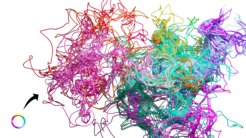Wool balls in the wind: The geometry of turbulent mixing
Anyone who regularly stirs their coffee knows about the advantages of turbulent mixing: the movement of the spoon creates a turbulent flow that can distribute the milk very quickly and evenly in the cup. Moreover, turbulent mixing is also responsible for the distribution of gasoline in the engine cylinder or of dust particles in the atmosphere. The research group led by Prof. Michael Wilczek at the Max Planck Institute for Dynamics and Self-Organization and the University of Bayreuth has now succeeded in better understanding the geometry of turbulent mixing; their results were recently published in Nature Communications.

When a drop of paint is released into a flow of water, one can observe how it increasingly deforms and folds. To the naked eye, this process eventually results in a cloud of paint within which fine-scale features cannot be distinguished anymore. But what if the process of deformation could be observed with ever greater precision? As the authors of the study showed, this is possible in computer simulations of turbulent flows: "Our goal was to study the deformation of the simplest possible structures by turbulent flow. Therefore, we decided to use small rings - so-called lines of matter. These small 'smoke rings' are deformed by strong turbulence over time and quickly take on incredibly complex shapes," said Prof. Theodore Drivas of Stony Brook University near New York, co-author and one of the originators of the study's ideas.
Indeed, the rings in the simulations quickly resemble complex balls of wool (see video), and their knotting reflects how the turbulent mixing has developed.
Characterizing the geometric properties of the complex tangles is at the heart of the study. PhD student Lukas Bentkamp, lead author of the study, explains, "When we took a closer look at the geometry of the lines, we immediately noticed that their curvature followed a clearly defined statistical distribution - even though the lines looked more and more complicated over time." In their study, the researchers uncovered the mechanisms of turbulent deformation and developed a mathematical theory of the curvature statistics of material lines. "So, in a statistical sense, we were able to find and explain clear regularities in the turbulent mess," Lukas Bentkamp said.
Even though stirring coffee in a cup is so commonplace, there is still no generally applicable theory to quantitatively capture such turbulent mixing. By elucidating aspects such as turbulent deformation, mixing processes in our environment could be better understood in the future.
